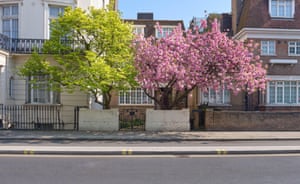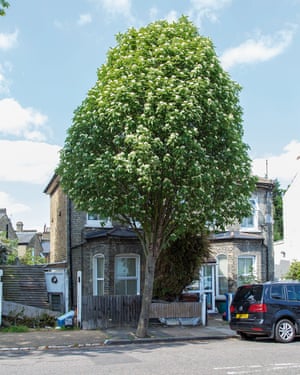An online mapping tool featuring the location and species of more than 700,000 trees in London has had a fiftyfold increase in visitors to its site since the coronavirus lockdown measures were put in place.
The founders of TreeTalk, which creates a walk specific to a user’s location and identifies trees on the route, say an increase in people spending more time at home getting to know their natural surroundings has led to a surge in interest. There are now calls to bring the app to other cities in the UK and abroad. TreeTalk is currently discussing a proposal with an east coast city in the US, while cities in Australia and India have also expressed interest.
In May alone there were 16,000 requests from users to create a personalised tree walk and 10,000 visitors a week to the site, an increase of 5,000% on the same three-month period during spring last year.
TreeTalk
(@treetalkuk)Did you know that #TreeTalk is not just a map. If you live in / around London you can create personalised trails as well for your #onedailywalk. Just go to https://t.co/Qn6haQt21T and enter your address and we’ll do all the work. #dailywalk #onewalkaday #WalkWhereYouMay pic.twitter.com/cb9xvxg1w2
“During the lockdown period we’ve seen a huge growth in people wanting to get out and explore their local streets, leading to an overall positive impact on their health and wellbeing,” said Rob Tustain, director of Revolution Consultancy & Design which created TreeTalk in 2017 using data released by the mayor of London’s environment team.
The Greater London authority data combined information provided by the city’s boroughs and Transport for London, which plants and maintains trees on the capital’s busiest roads.
Q&A Why are trees good for the environment?
Show
Hide
There are about three trillion trees on the planet and they play a major role in producing the oxygen we all breathe. But twice as many existed before the start of human civilisation.
Today, 10 billion more trees are cut down than are planted every year. This destruction is a significant contributor to the carbon emissions that are driving the climate crisis. However, trees draw carbon dioxide back out of the atmosphere as they grow, and planting trees will need to play an important part in ending the climate emergency.
Forests are also a vital and rich habitat for wildlife. Earth is at the start of a sixth mass extinction of species and the razing of forests and other ecosystems is the biggest contributor to the losses. Tropical rainforests are especially important, hosting 50% of known terrestrial species on only 6% of the world’s land. Trees are also important in controlling regional rainfall, as they evaporate water from their leaves.
In urban areas, the shade from trees has been shown to both cool city streets and reduce levels of air pollution. They can also boost people’s wellbeing as part of green spaces, with research showing two-hour “dose” of nature a week significantly improving health.
Tustain said: “Although our data is currently for Greater London, traffic to the website has been generated from around the UK, showing a huge appetite from other cities, including Bristol, Manchester, Edinburgh, Birmingham and Glasgow.”
The growth of interest in trees matches that shown in plants. A growing army of rebel botanists have taken to chalking the names of plants on the streets of towns and cities in France, the UK and beyond.
In London’s Street Trees, A Field Guide to the Urban Forest, author Paul Wood explains how the city’s frequent rain and mild winters – coupled with an urban heat island that raises temperatures above those of the surrounding countryside – enable a vast range of tree species to thrive.
He describes London as a botanical melting pot where common native species such as ash (Fraxinus excelsior), oak (Quercus robur) and hawthorn (Crataegus monogyna) live cheek by jowl with strains from across the globe such as eucalyptus (Eucalyptus spp.), loquat (Eriobotrya japonica) and tree of heaven (Ailanthus altissima).
Wood, who co-founded TreeTalk, said: “During lockdown more people have been exercising locally while we’ve had extraordinary good weather and less traffic, pollution and noise. This has allowed people the headspace to realise what is on their streets and see the city from a natural perspective.”

Asked why he thought people felt particularly drawn to trees during this period, Wood said: “The wonder of nature is a cliche but trees are a truth at a time when there is a lot of uncertainty. There is a conceptual mystery to the way they manage to burst into life every spring despite everything we throw at them – the vans and buses going by, the extreme weather, the pollution.”
There are more than 8m trees in the capital – almost one for every Londoner – and the the TreeTalk map and trails feature more than 600 species.
Simply enter a postcode and it will generate a walk telling the stories of the trees on the way, from some of the most common species such as the famous London plane (Platanus x hispanica) or the sycamore (Acer pseudoplatanus), to the rarer Amur maple (Acer ginnala) and Vilmorin’s rowan (Sorbus vilmorinii), of which there are fewer than 10 in London. Such trees are marked gold to indicate their rarity, while silver and bronze trees have fewer than 75 and 200 of that species respectively.
Lily
(@Wild_London_)#urbantreefestival #londonnationalparkcity
This week I have been labeling the local trees of my neighbourhood using the #treetalk tree finder map. Turns out we have quite a few rare trees! #w3 #ealing pic.twitter.com/bObuUwMhtL
Tustain said: “The ratings for trees have proved really popular … one user even described it as “much funner than Pokemon Go”. Indirectly, it has created a bit of competition and tree envy among friends living in the same borough.”
The app is constantly updated, and while there are still some gaps because seven boroughs have not yet provided their street data, there are further opportunities to enhance the platform.
“One long-term plan is to overlay the tree details with other data to look at air pollution monitoring,” said Wood. The app could then show the least polluted route to the tube station, for example.
Wood, Tustain and a third collaborator, Steve Pocock, who develops technology solutions, are also seeking to engage with communities on how people can get more trees planted in their neighbourhoods.
“We are looking for help from local authorities and land owners that could see the benefits for their residents,” said Wood.

The surge of interest in trees was highlighted last month when the Urban Tree festival was forced online for the first time. More than 5,000 people from around the world booked events, the number only limited by the capacity of Zoom. Those that participated in a virtual tour of St James’s Park joined from cities including Tallinn and Toronto, while a tour of ancient trees in London booked out in hours and received more than 30,000 views on Facebook.
Among the speakers was Robin Walter, whose book Living With Trees is described as a “powerful call for more trees in our lives”.
Walter says caring for trees and woods can lead to greater community cohesion and wellbeing.
“Trees inhabit a social space and are long-lasting landmarks that make a real contribution to everyone’s lives. Aside from their form and beauty, they filter pollutants, screen us from noise and shade us from the sun. They even put out feelgood ions – there are literally aerosols wafting around trees that make you feel better.”
Find more age of extinction coverage here, and follow biodiversity reporters Phoebe Weston and Patrick Greenfield on Twitter for all the latest news and features